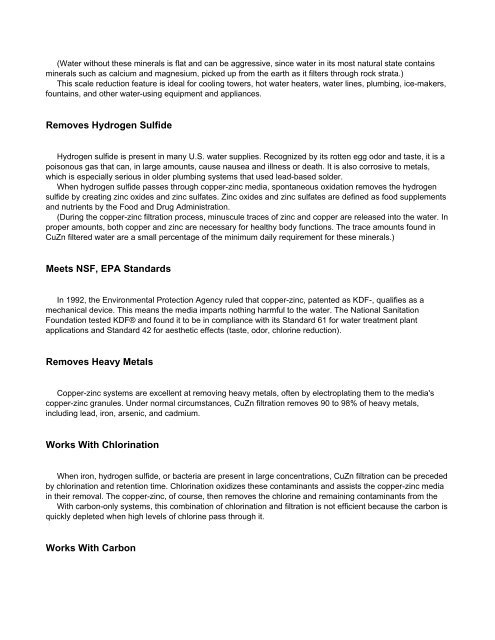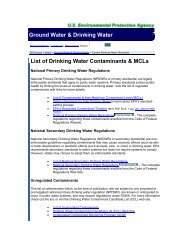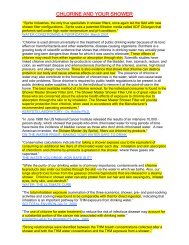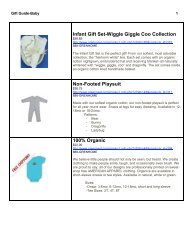(PDF) How copper-zinc water treatment systems work - Green Nest
(PDF) How copper-zinc water treatment systems work - Green Nest
(PDF) How copper-zinc water treatment systems work - Green Nest
You also want an ePaper? Increase the reach of your titles
YUMPU automatically turns print PDFs into web optimized ePapers that Google loves.
(Water without these minerals is flat and can be aggressive, since <strong>water</strong> in its most natural state contains<br />
minerals such as calcium and magnesium, picked up from the earth as it filters through rock strata.)<br />
This scale reduction feature is ideal for cooling towers, hot <strong>water</strong> heaters, <strong>water</strong> lines, plumbing, ice-makers,<br />
fountains, and other <strong>water</strong>-using equipment and appliances.<br />
Removes Hydrogen Sulfide<br />
Hydrogen sulfide is present in many U.S. <strong>water</strong> supplies. Recognized by its rotten egg odor and taste, it is a<br />
poisonous gas that can, in large amounts, cause nausea and illness or death. It is also corrosive to metals,<br />
which is especially serious in older plumbing <strong>systems</strong> that used lead-based solder.<br />
When hydrogen sulfide passes through <strong>copper</strong>-<strong>zinc</strong> media, spontaneous oxidation removes the hydrogen<br />
sulfide by creating <strong>zinc</strong> oxides and <strong>zinc</strong> sulfates. Zinc oxides and <strong>zinc</strong> sulfates are defined as food supplements<br />
and nutrients by the Food and Drug Administration.<br />
(During the <strong>copper</strong>-<strong>zinc</strong> filtration process, minuscule traces of <strong>zinc</strong> and <strong>copper</strong> are released into the <strong>water</strong>. In<br />
proper amounts, both <strong>copper</strong> and <strong>zinc</strong> are necessary for healthy body functions. The trace amounts found in<br />
CuZn filtered <strong>water</strong> are a small percentage of the minimum daily requirement for these minerals.)<br />
Meets NSF, EPA Standards<br />
In 1992, the Environmental Protection Agency ruled that <strong>copper</strong>-<strong>zinc</strong>, patented as KDF-, qualifies as a<br />
mechanical device. This means the media imparts nothing harmful to the <strong>water</strong>. The National Sanitation<br />
Foundation tested KDF® and found it to be in compliance with its Standard 61 for <strong>water</strong> <strong>treatment</strong> plant<br />
applications and Standard 42 for aesthetic effects (taste, odor, chlorine reduction).<br />
Removes Heavy Metals<br />
Copper-<strong>zinc</strong> <strong>systems</strong> are excellent at removing heavy metals, often by electroplating them to the media's<br />
<strong>copper</strong>-<strong>zinc</strong> granules. Under normal circumstances, CuZn filtration removes 90 to 98% of heavy metals,<br />
including lead, iron, arsenic, and cadmium.<br />
Works With Chlorination<br />
When iron, hydrogen sulfide, or bacteria are present in large concentrations, CuZn filtration can be preceded<br />
by chlorination and retention time. Chlorination oxidizes these contaminants and assists the <strong>copper</strong>-<strong>zinc</strong> media<br />
in their removal. The <strong>copper</strong>-<strong>zinc</strong>, of course, then removes the chlorine and remaining contaminants from the<br />
With carbon-only <strong>systems</strong>, this combination of chlorination and filtration is not efficient because the carbon is<br />
quickly depleted when high levels of chlorine pass through it.<br />
Works With Carbon





